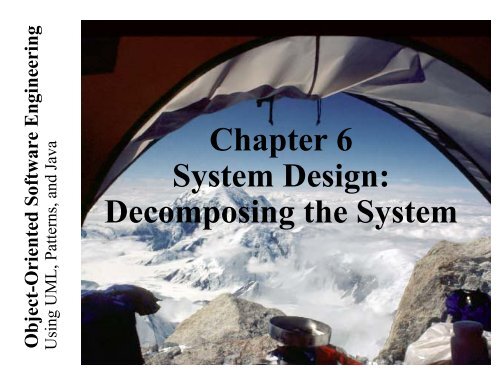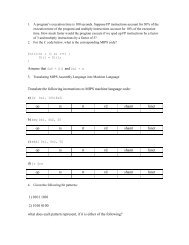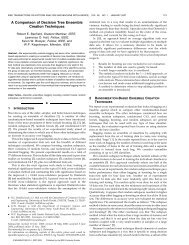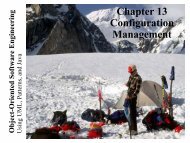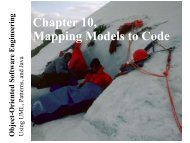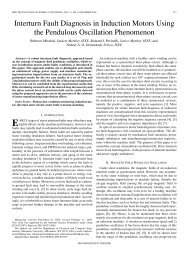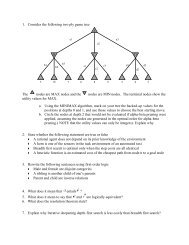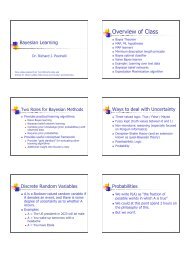Chapter 6 System Design: Decomposing the System
Chapter 6 System Design: Decomposing the System
Chapter 6 System Design: Decomposing the System
Create successful ePaper yourself
Turn your PDF publications into a flip-book with our unique Google optimized e-Paper software.
<strong>Chapter</strong> 6<br />
<strong>System</strong> <strong>Design</strong>:<br />
<strong>Decomposing</strong> <strong>the</strong> <strong>System</strong><br />
Using UML, Patterns, and Java<br />
Object-Oriented Software Engineering
<strong>Design</strong><br />
“There are two ways of constructing a software<br />
design: One way is to make it so simple that <strong>the</strong>re are<br />
obviously no deficiencies, and <strong>the</strong> o<strong>the</strong>r way is to<br />
make it so complicated that <strong>the</strong>re are no obvious<br />
deficiencies.”<br />
- C.A.R. Hoare<br />
Bernd Bruegge & Allen H. Dutoit Object-Oriented Software Engineering: Using UML, Patterns, and Java 2
Why is <strong>Design</strong> so Difficult<br />
♦ Analysis: Focuses on <strong>the</strong> application domain<br />
♦ <strong>Design</strong>: Focuses on <strong>the</strong> solution domain<br />
• <strong>Design</strong> knowledge is a moving target<br />
• The reasons for design decisions are changing very rapidly<br />
<br />
<br />
<br />
Halftime knowledge in software engineering: About 3-5 years<br />
What I teach today will be out of date in 3 years<br />
Cost of hardware rapidly sinking<br />
♦ “<strong>Design</strong> window”:<br />
• Time in which design decisions have to be made<br />
♦ Technique<br />
• Time-boxed prototyping<br />
Bernd Bruegge & Allen H. Dutoit Object-Oriented Software Engineering: Using UML, Patterns, and Java 3
The Purpose of <strong>System</strong> <strong>Design</strong><br />
Problem<br />
♦ Bridging <strong>the</strong> gap between desired<br />
and existing system in a<br />
manageable way<br />
♦ Use Divide and Conquer<br />
• We model <strong>the</strong> new system to be<br />
developed as a set of subsystems<br />
New<br />
<strong>System</strong><br />
Existing <strong>System</strong><br />
Bernd Bruegge & Allen H. Dutoit Object-Oriented Software Engineering: Using UML, Patterns, and Java 4
<strong>System</strong> <strong>Design</strong><br />
<strong>System</strong> <strong>Design</strong><br />
1. <strong>Design</strong> Goals<br />
Definition<br />
Trade-offs<br />
2. <strong>System</strong><br />
Decomposition<br />
Layers/Partitions<br />
Cohesion/Coupling<br />
3. Concurrency<br />
Identification of<br />
Threads<br />
4. Hardware/<br />
Software<br />
Mapping<br />
Special purpose<br />
Buy or Build Trade-off<br />
Allocation<br />
Connectivity<br />
5. Data<br />
Management<br />
Persistent Objects<br />
Files<br />
Databases<br />
Data structure<br />
6. Global<br />
Resource Handling<br />
Access control<br />
Security<br />
8. Boundary<br />
Conditions<br />
Initialization<br />
Termination<br />
Failure<br />
7. Software<br />
Control<br />
Monolithic<br />
Event-Driven<br />
Threads<br />
Conc. Processes<br />
Bernd Bruegge & Allen H. Dutoit Object-Oriented Software Engineering: Using UML, Patterns, and Java 5
Overview<br />
<strong>System</strong> <strong>Design</strong> I (This week – <strong>Chapter</strong> 6)<br />
0. Overview of <strong>System</strong> <strong>Design</strong><br />
1. <strong>Design</strong> Goals<br />
2. Subsystem Decomposition<br />
<strong>System</strong> <strong>Design</strong> II: Addressing <strong>Design</strong> Goals (Next week –<br />
<strong>Chapter</strong> 7)<br />
3. Concurrency<br />
4. Hardware/Software Mapping<br />
5. Persistent Data Management<br />
6. Global Resource Handling and Access Control<br />
7. Software Control<br />
8. Boundary Conditions<br />
Bernd Bruegge & Allen H. Dutoit Object-Oriented Software Engineering: Using UML, Patterns, and Java 6
How to use <strong>the</strong> results from <strong>the</strong> Requirements<br />
Analysis for <strong>System</strong> <strong>Design</strong><br />
♦ Nonfunctional requirements =><br />
• Activity 1: <strong>Design</strong> Goals Definition<br />
♦ Functional model =><br />
• Activity 2: <strong>System</strong> decomposition (Selection of subsystems based on<br />
functional requirements, cohesion, and coupling)<br />
♦ Object model =><br />
• Activity 4: Hardware/software mapping<br />
• Activity 5: Persistent data management<br />
♦ Dynamic model =><br />
• Activity 3: Concurrency<br />
• Activity 6: Global resource handling<br />
• Activity 7: Software control<br />
♦ Subsystem Decomposition<br />
• Activity 8: Boundary conditions<br />
Bernd Bruegge & Allen H. Dutoit Object-Oriented Software Engineering: Using UML, Patterns, and Java 7
How do we get <strong>the</strong> <strong>Design</strong> Goals<br />
Let’s look at a small example<br />
Current Situation:<br />
• Computers must be used in <strong>the</strong> office<br />
What we want:<br />
• A computer that can be used in mobile situations.<br />
Bernd Bruegge & Allen H. Dutoit Object-Oriented Software Engineering: Using UML, Patterns, and Java 8
Example: Current Desktop Development<br />
Bernd Bruegge & Allen H. Dutoit Object-Oriented Software Engineering: Using UML, Patterns, and Java 9
Identify Current Technology Constraints<br />
Single Output<br />
Device<br />
Direction where <strong>the</strong><br />
user looks is<br />
irrelevant<br />
Fixed Network<br />
Connection<br />
Location of<br />
user does not<br />
matter<br />
Precise Input<br />
Bernd Bruegge & Allen H. Dutoit Object-Oriented Software Engineering: Using UML, Patterns, and Java 10
Generalize Constraints using Technology Enable<br />
Multiple Single Output<br />
Devices<br />
Direction where <strong>the</strong><br />
user looks is<br />
irrelevant relevant<br />
Dynamic Fixed Network<br />
Connection<br />
Location of<br />
Location-based<br />
user does not<br />
matter<br />
Vague Precise Input<br />
Bernd Bruegge & Allen H. Dutoit Object-Oriented Software Engineering: Using UML, Patterns, and Java 11
Establish New <strong>Design</strong> Goals<br />
Mobile Network Connection<br />
Multiple Output Devices<br />
Location-Based<br />
Multimodal Input (Users Gaze, Users Location, …)<br />
Vague input<br />
Bernd Bruegge & Allen H. Dutoit Object-Oriented Software Engineering: Using UML, Patterns, and Java 12
Sharpen <strong>the</strong> <strong>Design</strong> Goals<br />
Location-based input<br />
• Input depends on user location<br />
• Input depends on <strong>the</strong> direction where <strong>the</strong> user<br />
looks (“egocentric systems”)<br />
Multi-modal input<br />
• The input comes from more than one input device<br />
Dynamic connection<br />
• Contracts are only valid for a limited time<br />
Is <strong>the</strong>re a possibility of fur<strong>the</strong>r generalizations<br />
Example: location can be seen as a special case of context<br />
• User preference is part of <strong>the</strong> context<br />
• Interpretation of commands depends on context<br />
Bernd Bruegge & Allen H. Dutoit Object-Oriented Software Engineering: Using UML, Patterns, and Java 13
List of <strong>Design</strong> Goals<br />
♦ Reliability<br />
♦ Modifiability<br />
♦ Maintainability<br />
♦ Understandability<br />
♦ Adaptability<br />
♦ Reusability<br />
♦ Efficiency<br />
♦ Portability<br />
♦ Traceability of requirements<br />
♦ Fault tolerance<br />
♦ Backward-compatibility<br />
♦ Cost-effectiveness<br />
♦ Robustness<br />
♦ High-performance<br />
Good documentation<br />
Well-defined interfaces<br />
User-friendliness<br />
Reuse of components<br />
Rapid development<br />
Minimum # of errors<br />
Readability<br />
Ease of learning<br />
Ease of remembering<br />
Ease of use<br />
Increased productivity<br />
Low-cost<br />
Flexibility<br />
Bernd Bruegge & Allen H. Dutoit Object-Oriented Software Engineering: Using UML, Patterns, and Java 14
Classroom Activity – <strong>Design</strong> Goals<br />
♦<br />
♦<br />
Description: Identify and prioritize<br />
<strong>the</strong> design goals for your project.<br />
Process:<br />
• Meet as teams<br />
<br />
Choose a scribe to record design goals<br />
• Identify top 5 – 10 ordered design<br />
goals (<strong>the</strong>re may be more or less).<br />
• You have about 5 minutes.<br />
Bernd Bruegge & Allen H. Dutoit Object-Oriented Software Engineering: Using UML, Patterns, and Java 15
Relationship Between <strong>Design</strong> Goals<br />
End User<br />
Low cost<br />
Increased Productivity<br />
Backward-Compatibility<br />
Traceability of requirements<br />
Rapid development<br />
Flexibility<br />
Client<br />
(Customer,<br />
Sponsor)<br />
Nielson<br />
Usability Engineering<br />
MMK, HCI<br />
Rubin<br />
Task Analysis<br />
Runtime<br />
Efficiency<br />
Reliability<br />
Portability<br />
Good Documentation<br />
Minimum # of errors<br />
Modifiability, Readability<br />
Reusability, Adaptability<br />
Well-defined interfaces<br />
Functionality<br />
User-friendliness<br />
Ease of Use<br />
Ease of learning<br />
Fault tolerant<br />
Robustness<br />
Developer/<br />
Maintainer<br />
Bernd Bruegge & Allen H. Dutoit Object-Oriented Software Engineering: Using UML, Patterns, and Java 16
Typical <strong>Design</strong> Trade-offs<br />
♦ Functionality vs. Usability<br />
♦ Cost vs. Robustness<br />
♦ Efficiency vs. Portability<br />
♦ Rapid development vs. Functionality<br />
♦ Cost vs. Reusability<br />
♦ Backward Compatibility vs. Readability<br />
Bernd Bruegge & Allen H. Dutoit Object-Oriented Software Engineering: Using UML, Patterns, and Java 17
Nonfunctional Requirements may give a clue for <strong>the</strong><br />
use of <strong>Design</strong> Patterns<br />
♦ Read <strong>the</strong> problem statement again<br />
♦ Use textual clues (similar to Abbot’s technique in Analysis) to<br />
identify design patterns<br />
♦ Text: “manufacturer independent”, “device independent”,<br />
“must support a family of products”<br />
• Abstract Factory Pattern<br />
♦ Text: “must interface with an existing object”<br />
• Adapter Pattern<br />
♦ Text: “must deal with <strong>the</strong> interface to several systems, some of<br />
<strong>the</strong>m to be developed in <strong>the</strong> future”, “ an early prototype must<br />
be demonstrated”<br />
• Bridge Pattern<br />
Bernd Bruegge & Allen H. Dutoit Object-Oriented Software Engineering: Using UML, Patterns, and Java 18
Textual Clues in Nonfunctional Requirements<br />
♦ Text: “complex structure”, “must have variable depth and<br />
width”<br />
• Composite Pattern<br />
♦ Text: “must interface to an set of existing objects”<br />
• Façade Pattern<br />
♦ Text: “must be location transparent”<br />
• Proxy Pattern<br />
♦ Text: “must be extensible”, “must be scalable”<br />
• Observer Pattern<br />
♦ Text: “must provide a policy independent from <strong>the</strong> mechanism”<br />
• Strategy Pattern<br />
Bernd Bruegge & Allen H. Dutoit Object-Oriented Software Engineering: Using UML, Patterns, and Java 19
Section 2. <strong>System</strong> Decomposition<br />
♦ Subsystem (UML: Package)<br />
• Collection of classes, associations, operations, events and constraints<br />
that are interrelated<br />
• Seed for subsystems: UML Objects and Classes.<br />
♦ (Subsystem) Service:<br />
• Group of operations provided by <strong>the</strong> subsystem<br />
• Seed for services: Subsystem use cases<br />
♦ Service is specified by Subsystem interface:<br />
• Specifies interaction and information flow from/to subsystem<br />
boundaries, but not inside <strong>the</strong> subsystem.<br />
• Should be well-defined and small.<br />
• Often called API: Application programmer’s interface, but this<br />
term should used during implementation, not during <strong>System</strong><br />
<strong>Design</strong><br />
Bernd Bruegge & Allen H. Dutoit Object-Oriented Software Engineering: Using UML, Patterns, and Java 20
Services and Subsystem Interfaces<br />
♦ Service: A set of related operations that share a common<br />
purpose<br />
• Notification subsystem service:<br />
<br />
<br />
<br />
<br />
LookupChannel()<br />
SubscribeToChannel()<br />
SendNotice()<br />
UnscubscribeFromChannel()<br />
• Services are defined in <strong>System</strong> <strong>Design</strong><br />
♦ Subsystem Interface: Set of fully typed related operations.<br />
• Subsystem Interfaces are defined in Object <strong>Design</strong><br />
• Also called application programmer interface (API)<br />
Bernd Bruegge & Allen H. Dutoit Object-Oriented Software Engineering: Using UML, Patterns, and Java 21
Choosing Subsystems<br />
♦ Criteria for subsystem selection: Most of <strong>the</strong> interaction should<br />
be within subsystems, ra<strong>the</strong>r than across subsystem boundaries<br />
(High cohesion).<br />
• Does one subsystem always call <strong>the</strong> o<strong>the</strong>r for <strong>the</strong> service<br />
• Which of <strong>the</strong> subsystems call each o<strong>the</strong>r for service<br />
♦ Primary Question:<br />
• What kind of service is provided by <strong>the</strong> subsystems (subsystem<br />
interface)<br />
♦ Secondary Question:<br />
• Can <strong>the</strong> subsystems be hierarchically ordered (layers)<br />
♦ What kind of model is good for describing layers and<br />
partitions<br />
Bernd Bruegge & Allen H. Dutoit Object-Oriented Software Engineering: Using UML, Patterns, and Java 22
Subsystem Decomposition Example<br />
Is this <strong>the</strong> right<br />
decomposition or<br />
is this too much ravioli<br />
Authoring<br />
Augmented<br />
Reality<br />
Modeling<br />
Workflow<br />
Inspection<br />
Workorder<br />
Repair<br />
Bernd Bruegge & Allen H. Dutoit Object-Oriented Software Engineering: Using UML, Patterns, and Java 23
Definition: Subsystem Interface Object<br />
♦ A Subsystem Interface Object provides a service<br />
• This is <strong>the</strong> set of public methods provided by <strong>the</strong><br />
subsystem<br />
• The Subsystem interface describes all <strong>the</strong> methods of <strong>the</strong><br />
subsystem interface object<br />
♦ Use a Facade pattern for <strong>the</strong> subsystem interface<br />
object<br />
Bernd Bruegge & Allen H. Dutoit Object-Oriented Software Engineering: Using UML, Patterns, and Java 24
<strong>System</strong> as a set of subsystems communicating via a<br />
software bus<br />
Authoring<br />
Modeling<br />
Workflow<br />
Inspection<br />
Augmented<br />
Reality<br />
Repair<br />
Workorder<br />
A Subsystem Interface Object publishes <strong>the</strong> service (= Set of public methods)<br />
provided by <strong>the</strong> subsystem<br />
Bernd Bruegge & Allen H. Dutoit Object-Oriented Software Engineering: Using UML, Patterns, and Java 25
A 3-layered Architecture<br />
Repair Inspection Authoring<br />
Augmented<br />
Reality<br />
Modeling<br />
Workflow<br />
What is <strong>the</strong> relationship between Modeling and Authoring<br />
Are o<strong>the</strong>r subsystems needed<br />
Bernd Bruegge & Allen H. Dutoit Object-Oriented Software Engineering: Using UML, Patterns, and Java 26
User Interface<br />
Ano<strong>the</strong>r Example:<br />
ARENA Subsystem<br />
decomposition<br />
Advertisement<br />
Tournament<br />
User Management<br />
Component<br />
Management<br />
User Directory<br />
Session<br />
Management<br />
Tournament<br />
Statistics<br />
Bernd Bruegge & Allen H. Dutoit Object-Oriented Software Engineering: Using UML, Patterns, and Java 27
User Interface<br />
Manages<br />
advertisement banners<br />
and sponsorships.<br />
Services provided by<br />
ARENA Subsystems<br />
Manages tournaments,<br />
applications,<br />
promotions.<br />
Administers user<br />
accounts<br />
Advertisement<br />
Component<br />
Management<br />
Tournament<br />
For adding games,<br />
styles, and expert<br />
rating formulas<br />
User Management<br />
User Directory<br />
Maintains state<br />
during matches.<br />
Session<br />
Management<br />
Tournament<br />
Statistics<br />
Stores results of<br />
archived<br />
tournaments<br />
Stores user profiles<br />
(contact &<br />
subscriptions)<br />
Bernd Bruegge & Allen H. Dutoit Object-Oriented Software Engineering: Using UML, Patterns, and Java 28
Coupling and Cohesion<br />
♦ Goal: Reduction of complexity while change occurs<br />
♦ Cohesion measures <strong>the</strong> dependence among classes<br />
• High cohesion: The classes in <strong>the</strong> subsystem perform similar tasks and<br />
are related to each o<strong>the</strong>r (via associations)<br />
• Low cohesion: Lots of miscellaneous and auxiliary classes, no<br />
associations<br />
♦ Coupling measures dependencies between subsystems<br />
• High coupling: Changes to one subsystem will have high impact on <strong>the</strong><br />
o<strong>the</strong>r subsystem (change of model, massive recompilation, etc.)<br />
• Low coupling: A change in one subsystem does not affect any o<strong>the</strong>r<br />
subsystem<br />
♦ Subsystems should have as maximum cohesion and minimum<br />
coupling as possible:<br />
• How can we achieve high cohesion<br />
• How can we achieve loose coupling<br />
Bernd Bruegge & Allen H. Dutoit Object-Oriented Software Engineering: Using UML, Patterns, and Java 29
Partitions and Layers<br />
Partitioning and layering are techniques to achieve low<br />
coupling.<br />
A large system is usually decomposed into subsystems using<br />
both, layers and partitions.<br />
♦ Partitions vertically divide a system into several independent<br />
(or weakly-coupled) subsystems that provide services on <strong>the</strong><br />
same level of abstraction.<br />
♦ A layer is a subsystem that provides subsystem services to a<br />
higher layers (level of abstraction)<br />
• A layer can only depend on lower layers<br />
• A layer has no knowledge of higher layers<br />
Bernd Bruegge & Allen H. Dutoit Object-Oriented Software Engineering: Using UML, Patterns, and Java 30
Subsystem Decomposition into Layers<br />
A: Subsystem Layer 1<br />
B:Subsystem<br />
C:Subsystem<br />
D:Subsystem<br />
Layer 2<br />
E:Subsystem<br />
F:Subsystem<br />
G:Subsystem<br />
Layer 3<br />
♦ Subsystem Decomposition Heuristics:<br />
♦ No more than 7+/-2 subsystems<br />
• More subsystems increase cohesion but also complexity (more<br />
services)<br />
♦ No more than 4+/-2 layers, use 3 layers (good)<br />
Bernd Bruegge & Allen H. Dutoit Object-Oriented Software Engineering: Using UML, Patterns, and Java 31
Classroom Activity – Partitioning<br />
♦<br />
♦<br />
Description: Partition you system<br />
into subsystems using <strong>the</strong> ideas of<br />
coupling and cohesion.<br />
Process:<br />
• Meet as teams<br />
<br />
Choose a scribe to record design goals<br />
• Use heuristics<br />
<br />
<br />
7 +/-2 subystems<br />
4+/-2 layers.<br />
• You have about 10 minutes.<br />
Bernd Bruegge & Allen H. Dutoit Object-Oriented Software Engineering: Using UML, Patterns, and Java 32
Relationships between Subsystems<br />
♦ Layer relationship<br />
• Layer A “Calls” Layer B (runtime)<br />
• Layer A “Depends on” Layer B (“make” dependency, compile<br />
time)<br />
♦ Partition relationship<br />
• The subsystem have mutual but not deep knowledge about each<br />
o<strong>the</strong>r<br />
• Partition A “Calls” partition B and partition B “Calls” partition A<br />
Bernd Bruegge & Allen H. Dutoit Object-Oriented Software Engineering: Using UML, Patterns, and Java 33
Virtual Machine<br />
♦ Dijkstra: T.H.E. operating system (1965)<br />
• A system should be developed by an ordered set of virtual<br />
machines, each built in terms of <strong>the</strong> ones below it.<br />
Problem<br />
C1<br />
attr<br />
opr<br />
C1<br />
attr<br />
opr<br />
C1<br />
attr<br />
opr<br />
VM1<br />
C1<br />
attr<br />
opr<br />
C1<br />
attr<br />
opr<br />
VM2<br />
C1<br />
attr<br />
opr<br />
C1<br />
attr<br />
opr<br />
VM3<br />
C1<br />
attr<br />
opr<br />
VM4<br />
Existing <strong>System</strong><br />
Bernd Bruegge & Allen H. Dutoit Object-Oriented Software Engineering: Using UML, Patterns, and Java 34
Virtual Machine<br />
♦ A virtual machine is an abstraction<br />
• It provides a set of attributes and operations.<br />
♦ A virtual machine is a subsystem<br />
• It is connected to higher and lower level virtual machines by<br />
"provides services for" associations.<br />
♦ Virtual machines can implement two types of software<br />
architecture<br />
• Open and closed architectures.<br />
Bernd Bruegge & Allen H. Dutoit Object-Oriented Software Engineering: Using UML, Patterns, and Java 35
Closed Architecture (Opaque Layering)<br />
♦ Any layer can only invoke<br />
operations from <strong>the</strong><br />
immediate layer below<br />
♦ <strong>Design</strong> goal: High<br />
maintainability, flexibility<br />
C1<br />
attr<br />
op<br />
C1<br />
attr<br />
op<br />
C1<br />
attr<br />
op<br />
C1<br />
attr<br />
op<br />
C1<br />
attr<br />
op<br />
C1<br />
attr<br />
op<br />
C1<br />
attr<br />
op<br />
VM1<br />
VM2<br />
VM3<br />
C1<br />
attr<br />
op<br />
C1<br />
attr<br />
op<br />
VM4<br />
Bernd Bruegge & Allen H. Dutoit Object-Oriented Software Engineering: Using UML, Patterns, and Java 36
Open Architecture (Transparent Layering)<br />
♦ Any layer can invoke<br />
operations from any layers<br />
below<br />
♦ <strong>Design</strong> goal: Runtime<br />
efficiency<br />
C1<br />
attr<br />
op<br />
C1<br />
attr<br />
op<br />
C1<br />
attr<br />
op<br />
C1<br />
attr<br />
op<br />
C1<br />
attr<br />
op<br />
C1<br />
attr<br />
op<br />
C1<br />
attr<br />
op<br />
VM1<br />
VM2<br />
VM3<br />
C1<br />
attr<br />
op<br />
C1<br />
attr<br />
op<br />
VM4<br />
Bernd Bruegge & Allen H. Dutoit Object-Oriented Software Engineering: Using UML, Patterns, and Java 37
Properties of Layered <strong>System</strong>s<br />
♦ Layered systems are hierarchical. They are desirable because<br />
hierarchy reduces complexity (by low coupling).<br />
♦ Closed architectures are more portable.<br />
♦ Open architectures are more efficient.<br />
♦ If a subsystem is a layer, it is often called a virtual machine.<br />
♦ Layered systems often have a chicken-and egg problem<br />
• Example: Debugger opening <strong>the</strong> symbol table when <strong>the</strong> file system<br />
needs to be debugged<br />
A: Debugger<br />
D: File <strong>System</strong><br />
G: Op. <strong>System</strong><br />
Bernd Bruegge & Allen H. Dutoit Object-Oriented Software Engineering: Using UML, Patterns, and Java 38
Software Architectural Styles<br />
♦ Subsystem decomposition<br />
• Identification of subsystems, services, and <strong>the</strong>ir relationship to each<br />
o<strong>the</strong>r.<br />
♦ Specification of <strong>the</strong> system decomposition is critical.<br />
♦ Patterns for software architecture<br />
• Client/Server<br />
• Peer-To-Peer<br />
• Repository<br />
• Model/View/Controller<br />
• Pipes and Filters<br />
Bernd Bruegge & Allen H. Dutoit Object-Oriented Software Engineering: Using UML, Patterns, and Java 39
Client/Server Architectural Style<br />
♦ One or many servers provides services to instances of<br />
subsystems, called clients.<br />
♦ Client calls on <strong>the</strong> server, which performs some service and<br />
returns <strong>the</strong> result<br />
• Client knows <strong>the</strong> interface of <strong>the</strong> server (its service)<br />
• Server does not need to know <strong>the</strong> interface of <strong>the</strong> client<br />
♦ Response in general immediately<br />
♦ Users interact only with <strong>the</strong> client<br />
Server<br />
Client<br />
*<br />
requester<br />
provider<br />
*<br />
service1()<br />
service2()<br />
…<br />
serviceN()<br />
Bernd Bruegge & Allen H. Dutoit Object-Oriented Software Engineering: Using UML, Patterns, and Java 40
Client/Server Architectural Style<br />
♦ Often used in database systems:<br />
• Front-end: User application (client)<br />
• Back end: Database access and manipulation (server)<br />
♦ Functions performed by client:<br />
• Customized user interface<br />
• Front-end processing of data<br />
• Initiation of server remote procedure calls<br />
• Access to database server across <strong>the</strong> network<br />
♦ Functions performed by <strong>the</strong> database server:<br />
• Centralized data management<br />
• Data integrity and database consistency<br />
• Database security<br />
• Concurrent operations (multiple user access)<br />
• Centralized processing (for example archiving)<br />
Bernd Bruegge & Allen H. Dutoit Object-Oriented Software Engineering: Using UML, Patterns, and Java 41
<strong>Design</strong> Goals for Client/Server <strong>System</strong>s<br />
♦ Service Portability<br />
• Server can be installed on a variety of machines and operating<br />
systems and functions in a variety of networking environments<br />
♦ Transparency, Location-Transparency<br />
• The server might itself be distributed (why), but should provide a<br />
single "logical" service to <strong>the</strong> user<br />
♦ Performance<br />
• Client should be customized for interactive display-intensive tasks<br />
• Server should provide CPU-intensive operations<br />
♦ Scalability<br />
• Server should have spare capacity to handle larger number of<br />
clients<br />
♦ Flexibility<br />
• The system should be usable for a variety of user interfaces and end<br />
devices (eg. WAP Handy, wearable computer, desktop)<br />
♦ Reliability<br />
• <strong>System</strong> should survive node or communication link problems<br />
Bernd Bruegge & Allen H. Dutoit Object-Oriented Software Engineering: Using UML, Patterns, and Java 42
Problems with Client/Server Architectural Styles<br />
♦ Layered systems do not provide peer-to-peer<br />
communication<br />
♦ Peer-to-peer communication is often needed<br />
♦ Example: Database receives queries from application but<br />
also sends notifications to application when data have<br />
changed<br />
Bernd Bruegge & Allen H. Dutoit Object-Oriented Software Engineering: Using UML, Patterns, and Java 43
Peer-to-Peer Architectural Style<br />
♦ Generalization of Client/Server Architecture<br />
♦ Clients can be servers and servers can be clients<br />
♦ More difficult because of possibility of deadlocks<br />
Peer<br />
requester<br />
*<br />
service1()<br />
service2()<br />
…<br />
serviceN()<br />
*<br />
provider<br />
application1:DBUser<br />
1. updateData<br />
database:DBMS<br />
application2:DBUser<br />
2. changeNotification<br />
Bernd Bruegge & Allen H. Dutoit Object-Oriented Software Engineering: Using UML, Patterns, and Java 44
Peer<br />
Client<br />
Server<br />
Bernd Bruegge & Allen H. Dutoit Object-Oriented Software Engineering: Using UML, Patterns, and Java 45
Example of a Peer-to-Peer<br />
Architectural Style<br />
Layer<br />
♦ ISO’s OSI Reference<br />
Model<br />
• ISO = International<br />
Standard<br />
Organization<br />
• OSI = Open <strong>System</strong><br />
Interconnection<br />
♦ Reference model<br />
defines 7 layers of<br />
network protocols and<br />
strict methods of<br />
communication<br />
between <strong>the</strong> layers.<br />
♦ Closed software<br />
architecture<br />
Level of abstraction<br />
Application<br />
Presentation<br />
Session<br />
Transport<br />
Network<br />
DataLink<br />
Physical<br />
Bernd Bruegge & Allen H. Dutoit Object-Oriented Software Engineering: Using UML, Patterns, and Java 46
OSI model Packages and <strong>the</strong>ir Responsibility<br />
♦ The Physical layer represents <strong>the</strong> hardware interface to <strong>the</strong> net-work. It<br />
allows to send() and receive bits over a channel.<br />
♦ The Datalink layer allows to send and receive frames without error using<br />
<strong>the</strong> services from <strong>the</strong> Physical layer.<br />
♦ The Network layer is responsible for that <strong>the</strong> data are reliably transmitted<br />
and routed within a network.<br />
♦ The Transport layer is responsible for reliably transmitting from end to<br />
end. (This is <strong>the</strong> interface seen by Unix programmers when transmitting<br />
over TCP/IP sockets)<br />
♦ The Session layer is responsible for initializing a connection, including<br />
au<strong>the</strong>ntication.<br />
♦ The Presentation layer performs data transformation services, such as byte<br />
swapping and encryption<br />
♦ The Application layer is <strong>the</strong> system you are designing (unless you build a<br />
protocol stack). The application layer is often layered itself.<br />
Bernd Bruegge & Allen H. Dutoit Object-Oriented Software Engineering: Using UML, Patterns, and Java 47
Ano<strong>the</strong>r View at <strong>the</strong> ISO Model<br />
• A closed software<br />
architecture<br />
• Each layer is a<br />
UML package<br />
containing a set of<br />
objects<br />
Application<br />
Presentation<br />
Session<br />
Format<br />
Connection<br />
Transport<br />
Message<br />
Network<br />
Packet<br />
DataLink<br />
Frame<br />
Physical<br />
Bit<br />
Bernd Bruegge & Allen H. Dutoit Object-Oriented Software Engineering: Using UML, Patterns, and Java 48
Middleware Allows Focus On The Application Layer<br />
Application<br />
Presentation<br />
Object<br />
CORBA<br />
Session<br />
Transport<br />
Socket<br />
Network<br />
TCP/IP<br />
DataLink<br />
Physical<br />
E<strong>the</strong>rnet<br />
Wire<br />
Bernd Bruegge & Allen H. Dutoit Object-Oriented Software Engineering: Using UML, Patterns, and Java 49
Model/View/Controller<br />
♦ Subsystems are classified into 3 different types<br />
• Model subsystem: Responsible for application domain knowledge<br />
• View subsystem: Responsible for displaying application domain objects<br />
to <strong>the</strong> user<br />
• Controller subsystem: Responsible for sequence of interactions with<br />
<strong>the</strong> user and notifying views of changes in <strong>the</strong> model.<br />
♦ MVC is a special case of a repository architecture:<br />
• Model subsystem implements <strong>the</strong> central datastructure, <strong>the</strong><br />
Controller subsystem explicitly dictate <strong>the</strong> control flow<br />
Controller<br />
initiator<br />
*<br />
1<br />
Model<br />
repository<br />
View<br />
subscriber<br />
*<br />
1<br />
notifier<br />
Bernd Bruegge & Allen H. Dutoit Object-Oriented Software Engineering: Using UML, Patterns, and Java 50
Example of a File <strong>System</strong> Based on <strong>the</strong> MVC<br />
Architectural Style<br />
Bernd Bruegge & Allen H. Dutoit Object-Oriented Software Engineering: Using UML, Patterns, and Java 51
Sequence of Events (Collaborations)<br />
2.User types new filename<br />
:Controller<br />
3. Request name change in model<br />
5. Updated views<br />
1. Views subscribe to event<br />
:InfoView<br />
:Model<br />
4. Notify subscribers<br />
:FolderView<br />
Bernd Bruegge & Allen H. Dutoit Object-Oriented Software Engineering: Using UML, Patterns, and Java 52
Repository Architectural Style (Blackboard<br />
Architecture, Hearsay II Speech Recognition <strong>System</strong>)<br />
♦ Subsystems access and modify data from a single data structure<br />
♦ Subsystems are loosely coupled (interact only through <strong>the</strong><br />
repository)<br />
♦ Control flow is dictated by central repository (triggers) or by<br />
<strong>the</strong> subsystems (locks, synchronization primitives)<br />
Repository<br />
Subsystem<br />
createData()<br />
setData()<br />
getData()<br />
searchData()<br />
Bernd Bruegge & Allen H. Dutoit Object-Oriented Software Engineering: Using UML, Patterns, and Java 53
Examples of Repository Architectural Style<br />
Compiler<br />
SyntacticAnalyzer<br />
LexicalAnalyzer<br />
SemanticAnalyzer<br />
Optimizer<br />
CodeGenerator<br />
♦ Hearsay II speech<br />
understanding system<br />
(“Blackboard<br />
architecture”)<br />
♦ Database Management<br />
<strong>System</strong>s<br />
♦ Modern Compilers<br />
Repository<br />
ParseTree<br />
SourceLevelDebugger<br />
SymbolTable<br />
SyntacticEditor<br />
Bernd Bruegge & Allen H. Dutoit Object-Oriented Software Engineering: Using UML, Patterns, and Java 54
Classroom Activity – Architectural Style<br />
♦<br />
♦<br />
Description: Select one of <strong>the</strong> architectural styles just<br />
discussed that best fits your system and redo <strong>the</strong> subsystem<br />
breakdown.<br />
Process:<br />
• Meet as teams<br />
Choose a scribe to record design goals<br />
• Use architectural styles/patterns<br />
Client/Server<br />
Peer-To-Peer<br />
Repository<br />
Model/View/Controller<br />
Pipes and Filters<br />
• Use heuristics<br />
7 +/-2 subystems<br />
4+/-2 layers.<br />
• You have about 10 minutes.<br />
Bernd Bruegge & Allen H. Dutoit Object-Oriented Software Engineering: Using UML, Patterns, and Java 55
Summary<br />
♦ <strong>System</strong> <strong>Design</strong><br />
• Reduces <strong>the</strong> gap between requirements and <strong>the</strong> (virtual) machine<br />
• Decomposes <strong>the</strong> overall system into manageable parts<br />
♦ <strong>Design</strong> Goals Definition<br />
• Describes and prioritizes <strong>the</strong> qualities that are important for <strong>the</strong><br />
system<br />
• Defines <strong>the</strong> value system against which options are evaluated<br />
♦ Subsystem Decomposition<br />
• Results into a set of loosely dependent parts which make up <strong>the</strong><br />
system<br />
Bernd Bruegge & Allen H. Dutoit Object-Oriented Software Engineering: Using UML, Patterns, and Java 56


